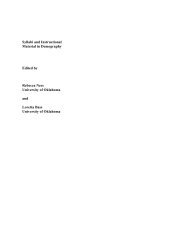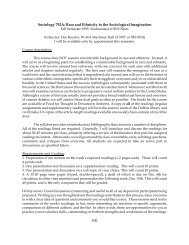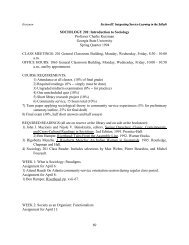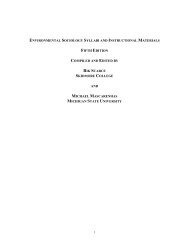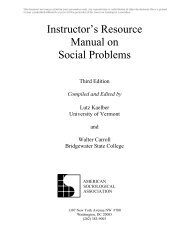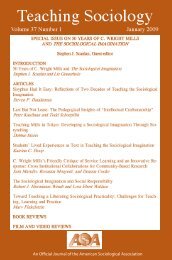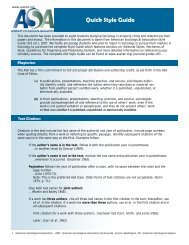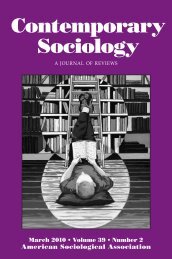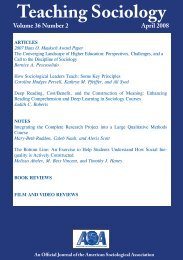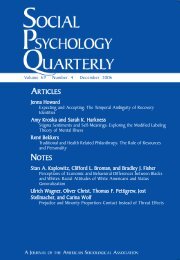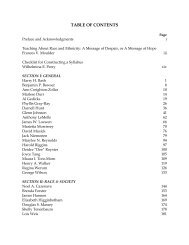SOCIOLOGY EDUCATION - American Sociological Association
SOCIOLOGY EDUCATION - American Sociological Association
SOCIOLOGY EDUCATION - American Sociological Association
Create successful ePaper yourself
Turn your PDF publications into a flip-book with our unique Google optimized e-Paper software.
250 Crosnoe<br />
<strong>American</strong>, and other race/ethnicity), family<br />
structure (1 = adolescent lived with both biological<br />
parents, 0 = another family form), and<br />
parental education (1 = less than high school<br />
graduation, 2 = high school graduate, 3 =<br />
some college, 4 = college graduate, 5 = postgraduate—maximum<br />
level taken in two-parent<br />
families).<br />
The second category, school characteristics,<br />
includes four factors. School level (1 =<br />
middle school, 0 = high school or comprehensive<br />
school) and sector (1 = private, 0 =<br />
public) were based on the reports of school<br />
administrators at Wave I. Because the In-<br />
School Survey was a near-census of each<br />
school, reports of parental education and<br />
race/ethnicity in this survey could be aggregated<br />
within schools to measure the proportion<br />
of students in each school who were<br />
nonwhite and had at least one parent with a<br />
college degree. The third category, adolescents’<br />
characteristics, includes measured ability<br />
(percentile scores on a modified version of<br />
the Peabody Picture Vocabulary Test) and athletic<br />
status (1 = adolescent on a sports team<br />
at school, 0 = no participation). The fourth<br />
category, social relationships, includes two<br />
network-derived items: number of friends (a<br />
count of friends nominated by the adolescent)<br />
and involvement with friends (the sum<br />
of whether or not the adolescent had hung<br />
out with, talked with, spent time with, or visited<br />
the nominated friend in the past week,<br />
averaged across all nominated friends).<br />
Romantic involvement was a binary measure<br />
(1 = adolescent reported having a serious<br />
boyfriend or girlfriend, 0 = no such relationship).<br />
Plan of Analyses<br />
The analyses proceeded in two general steps,<br />
with some preliminary and ancillary analyses<br />
along the way. In the first step, Wave III college<br />
enrollment was regressed on the Wave I<br />
selection factors, adolescent obesity, the two<br />
measures of the prevalence of obesity in the<br />
school, and then interactions between adolescent<br />
obesity and the two school obesity<br />
measures. The results of these models<br />
assessed differences in college enrollment<br />
after high school by obesity category during<br />
middle school or high school and the degree<br />
to which these differences varied according<br />
to the proportion of the student body of the<br />
school made up of obese girls or boys.<br />
If these initial models revealed significant<br />
obesity-related differences in college enrollment,<br />
then the second step was to investigate<br />
possible psychosocial mediators of these differences.<br />
This investigation required that obesity<br />
be associated with the psychosocial factors<br />
(Path A1 in Figure 1); that the psychosocial<br />
factors be associated with college enrollment<br />
(Path A2 in Figure 1); and, finally, that<br />
taking the psychosocial factors into account<br />
attenuated the initially observed associations<br />
between obesity and college enrollment. To<br />
establish mediation in this way, the six Wave<br />
II psychosocial adjustment factors were first<br />
regressed on Wave I selection factors (including<br />
the Wave I version of the psychosocial factors),<br />
adolescent obesity, the two measures of<br />
the prevalence of obesity in the school, and<br />
then interactions between adolescent obesity<br />
and the two school obesity measures. These<br />
models demonstrated whether obesity was<br />
associated with changes in six psychosocial<br />
problems over a one-year period and whether<br />
these associations varied by the proportion of<br />
obese boys and girls in school (testing Paths<br />
A1 and B in Figure 1). Next, the original college-enrollment<br />
models were expanded to<br />
include these six Wave II psychosocial factors.<br />
2 The results of these models gauged the<br />
degree of association between psychosocial<br />
adjustment during secondary school and college<br />
enrollment after secondary school (testing<br />
Path A2 in Figure 1). Moreover, a comparison<br />
of the obesity coefficients and the<br />
obesity x school obesity interaction terms<br />
before and after the inclusion of these psychosocial<br />
factors revealed the degree to<br />
which the association between Wave I obesity<br />
and Wave III college enrollment—and the<br />
school-by-school variation in this association—was<br />
explained by psychosocial adjustment<br />
at Wave II.<br />
All the models were estimated separately<br />
for boys and girls with the mixed procedure,<br />
the SAS version of multilevel modeling<br />
(Singer 1998). Multilevel techniques provided<br />
the most accurate estimates of school effects<br />
and corrected the violations of independence



